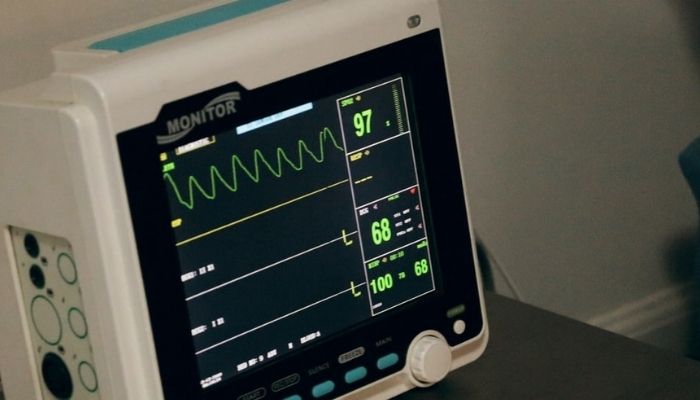We see them frequently in medical television shows and films, and if you’ve ever found yourself in a hospital’s emergency department, you’ve almost certainly seen the patient monitor screen.
Or, when working in a crowded Emergency Department, it’s critical to understand how a typical patient monitor looks and how to interpret all of its components.
Essential vital signs such as pulse, temperature, breathing, oxygen saturation, and blood pressure examine by patient monitors. These are often confusing due to the abundance of numbers, abbreviations, wavy lines, and beeping sounds.
If you’re looking at a patient monitor in a hospital and unsure what it all means, begin by identifying the abbreviation for each number or wavy line in the upper left-hand corner. As such, our article on How to Read an ICU Monitor will assist, as it discusses the majority of the basic standard parameters of a patient monitor.
From this snapshot, most healthcare professionals can tell you that the patient is in excellent health, with no heart or lung problems, adequate blood perfusion, and a regular breathing pattern.
Why are ICU Monitors Used?
Blood pressure displays on ICU monitors via an arterial catheter and an external pressure cuff; blood oxygen saturation shows via a pulse oximeter. Heart rate and respiratory rate express via external transmitters and the electrocardiogram waveform.
Patients who are critically ill may also demand hemodynamic monitoring through the use of a pulmonary artery (PA) catheter.
Typically, the measurements obtained from a PA catheter are displayed, such as proper atrial pressure, central venous pressure, cardiac output, PA pressure and other measured parameters.
The ICU’s basic monitoring systems enable critical staff to watch all of the above-mentioned vital body parameters. Monitors alone are ineffective; critical care nurses and doctors must read and interpret the readings expertly.
ICU nurses continuously monitor physiologic patient parameters to ensure the patient’s stability. If any of your vital signs fall below safe levels, the monitor will make certain sounds.
How do Intensive Care Unit Monitors Work?
The monitor receives data from small sensors attached to your body. Specific sensors adhere to your skin while others clip to one of your fingers.
What do the Numeric Values mean on ICU monitors?
The procedures and methodologies outlined below can assist you in Reading an ICU Monitor.
How to Read an Intensive Care Unit Heart Monitor?
Patients in the intensive care unit are frequently on a heart monitor. The heart monitor’s purpose is to monitor the heart rate, how quickly or slowly it beats, and how regular or irregular the heartbeat is.
- Determine the flat or wavy line that runs between the peaks. It refers to as the P wave. It concludes with the beat’s first rise or dip. P waves determine the atria’s depolarization, which indicates a heart muscle contraction. In between the start of the P and the first Q or R wave, the time interval should be 12 and 2 seconds.
- If there is a dip, this is a Q wave or downstroke. It is an R wave or upward deflection if it is a spike. Q waves may be indicative of a heart attack or maybe typical. Only a physician has the authority to make this determination.
- Downward Stroke After an R Wave, below the P Line. It is an S wave if it exists. The QRS complex is the summation of these three waves, and it should last between.08 and.12 seconds in a healthy individual.
- Identify the Straight or Wavy Line Following the QRS Complex. It is the T wave, which measures ventricular repolarization of the heart muscle relaxing.
How to Interpret Blood Pressure Readings from an ICU Monitor?
Identify the higher of the two numbers. That’s the systolic blood pressure reading, which indicates the pressure inside the heart during a beat. Systolic pressure should be between 100 and 130, while diastolic pressure should be between 60 and 80. According to the Mayo Clinic, a normal systolic pressure should be between 90 and 120.
- Identify the lower of the two numbers. That’s the diastolic blood pressure or the pressure in the heart’s chambers between beats. Diastolic blood pressure should be around 60 and 80 mmHg.
- If the reading takes a blood pressure cuff rather than a machine, use the first value as the systolic pressure, and the second is the diastolic pressure.
Respiration Rate
Under “RR,” look for the respiration rate. The respiratory rate is the numerical value of breaths an individual takes in one minute. At rest, humans normally breathe at a pace of 12 to 16 breaths per minute. However, because the respiration rate may arise due to injury or disease, the number may be greater than 16.
The individual’s number may also increase if they move or speak. For instance, if you see a 17 in the RR section, the individual is taking 17 breaths per minute.
Oxygen Saturation
Under “SpO2,” locate the blood oxygen saturation level. This value shows the oxygen saturation level of the blood. This figure should be at least 95%, although it may be lower due to the individual’s illness or injury.
If the value falls below 90%, the individual’s oxygen saturation is deemed low, and they will almost certainly require oxygen. For instance, if the SpO2 part of the monitor reads 96, the individual’s blood oxygen saturation is 96 per cent.
Reading of Temperature
Under “TEMP,” locate the individual’s temperature. This box contains the individual’s body temperature. Adults’ average body temperature is 97.8 and 99 °F (36.6 and 37.2 °C).
However, a person’s body temperature can change significantly depending on their degree of activity, gender, food and fluid consumption, time of day, and menstrual cycle stage (for women).
For instance, if you see a 98.2 in the TEMP section, this indicates that the individual’s temperature is 98.2 °F (36.8 °C).
Reading of Pulse Rate
The pulse rate denotes by the letter “PR.” Adults have an average pulse rate of between 60 and 100 beats per minute. This figure may be lower when the individual is resting or sleeping and higher when sitting up, moving, or speaking.
When a person is hurt, ill, or feeling intense emotions, their pulse rate may also increase, and you may see a higher-than-normal reading in this section of the screen. For instance, if the PR box reads 85, the individual’s pulse rate is 85.
What Do the Lines Mean on ICU Monitors?

To comprehend these readings, you must first understand what each wave represents
CO2 Waveform
The CO2 Waveform aids in visualizing the amount of CO2 exhaled by a patient. Additionally, average CO2 waveforms have the shape of a circular rectangle.
Respiratory Waveform
The Respiratory Waveform can be beneficial for clinicians monitoring respiratory disorders such as apnea or dyspnea.
IBP (1,2) Waveform
The IBP (1,2) Waveform aids in visualizing the invasive blood pressure. Multiple waveforms displays on some patient monitors. For instance, ART (Arterial Blood Pressure) and CVP (Central Venous Blood Pressure) displays in our situation.
SpO2 Waveform
The SpO2 Waveform can determine if there are any circulatory or peripheral perfusion abnormalities. Additionally, each peak on the SpO2 Waveform should match closely with the heartbeat on the ECG Waveform. Additionally, oxygenated blood pumps out of the heart with each beating.
Preventing Common Issues
- Avoid obsessing over a single number. Generally, it is acceptable for one or more values on a patient monitor to be beyond the normal range. It may signal an issue in some instances, although it is frequently unrelated. If you discover that one of the numbers or waves on the monitor appears to be incorrect, consult with the patient’s doctor or nurse.
- Beeps and sirens assist workers in detecting changes in a patient’s condition and determining when an IV requires maintenance. However, these sounds are typically do not causing worry. If the monitor or the other piece of equipment begins to beep, contact a nurse to have it inspected. If the machine begins to beep, consult a nurse or medical expert.
- Keep in mind that vital indicators are only one aspect of an individual’s overall health. Nurses and doctors use them with other indications and symptoms to diagnose disorders.
FAQs Related to Reading an ICU Monitor?
What Is Normal RESP on a Hospital Monitor?
You were resting adult breaths between 12 and 16 times per minute. Oxygen saturation: This value indicates the amount of oxygen in your blood on a scale of 1 to 100. Usually, this level is 95 or over, and anything less than 90 indicates that your body may be receiving insufficient oxygen.
What Is SPO2 in Patient Monitor?
SPO2 determines with a pulse oximeter, which is a computerized monitor and probe combination. The probe may position the patient’s finger toe, nostril, or earlobe. The monitor then provides a readout indicating the oxygen saturation level of the patient’s blood.
What Causes a High Pulse Rate?
Even when a person is sitting peacefully, consistently elevated heart rates can occasionally cause by an irregular heart rhythm. A fast heart rate could also indicate that the heart muscle is weakened by a virus or another issue, forcing it to beat more frequently to pump enough blood to the rest of the body.
Conclusion
Monitors are particularly beneficial for rapidly detecting changes and issues in a patient’s condition. Monitoring is vital in critical care, as optimizing patients’ hemodynamics, ventilation, temperature, nutrition, and metabolism is critical for patient survival.
Therefore, to comprehend these readings, you should have a thorough understanding of how the monitor works and what the numbers and lines on the ICU monitor signify to comprehend the patient’s condition. Thus, after reading this post, I am sure you will understand How to Read an ICU Monitor?
Read More
